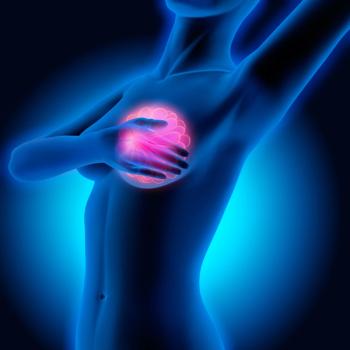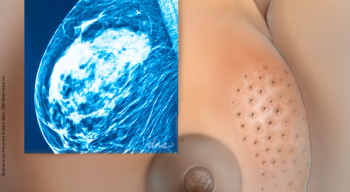
BRCA mutation carrying mothers may have different risks depending on whether the mutation is BRCA1 or BRCA2.


BRCA mutation carrying mothers may have different risks depending on whether the mutation is BRCA1 or BRCA2.

Exposure to high levels of DDT is known to increase risk of breast cancer and new research examined whether age of exposure and of diagnosis are connected.

A recent study aimed to quantify the effectiveness of improvements in screening and treatment.

Mammography is just one tool that ob/gyns should be using for breast cancer prevention and risk stratification.

An examination of ACOG’s updated guidelines on breast cancer screening recommendations for the average-risk woman.

Providing lactating mothers with accurate information on the effects of alcohol consumption is crucial even though data in this area are limited.

While minimally invasive and open surgeries have been found to produce similar survival rates in other early cancers, that might not be the case for early cervical cancer. PLUS: At what age should cervical cancer screening stop? ALSO: How much do genetic variants affect breast cancer risk?

Results of a new population-based study in the setting of school-based immunization and education cast doubt on speculation that teens who receive HPV vaccination practice unsafe sex. PLUS: Does 3D mammography detect more breast cancers? ALSO: Can weight loss reduce breast cancer risk in postmenopausal women?

A recent study looked at which approach to second-stage labor results in higher spontaneous vaginal delivery rates and lower rates of maternal and neonatal complications. PLUS: What makes hospitals safe for mothers and babies? ALSO: Does eating meat increase risk for breast cancer?

Babies born preterm are known to be at risk of alterations in brain structure and connectivity, but new research shows exposure to breastmilk may have cognitive benefits. PLUS: What’s behind postpartum opioid prescribing patterns? ALSO: How valuable is a second opinion for breast cancer diagnosis?

A new report shows that over a 10-year period in the United States, rates of severe maternal morbidity increased and age, race, and income, all played a role in disparities in specific related trends. PLUS: How are most women informed of a breast cancer diagnosis? ALSO: Does gestational diabetes signal long-term risk for mothers and their children?

Physicians are looking for ways to reduce unnecessary prescribing of opioids and dispensing after vaginal delivery may represent a source of over-prescription, according to a recently published study. PLUS: Can marijuana pass into mother's milk? ALSO: How do race and ethnicity impact HPV vaccine completion rates?

A study that tested the hypothesis that polycystic ovary syndrome (PCOS) is linked with autism may inform new interventions for PCOS and autism. PLUS: Does smoking exposure deter breastfeeding? ALSO: Does race play a role in maternal outcomes for older women?

Research point to risk as well as benefits of extended adjuvant tamoxifen for ER-positive BCa. PLUS: Should breast cancer screening be risk-based? ALSO: Side effects of cross-sex hormones in transwomen.

This article reviews recommendations for breastfeeding and current breastfeeding rates; positive maternal health outcomes associated with breastfeeding; and evidence-based practices that enable women to successfully achieve their breastfeeding goals.

Mammography is sufficient to predict breast cancer risk in women aged ≥ 60, but in younger women, combining mammography and genetic testing improves the assessment, according to a retrospective case-control study

A study by investigators from New England suggests that a mother’s diet during pregnancy and lactation may have an impact on the microbiome in her infant’s gut. PLUS: Are prenatal vitamin D levels tied to adverse pregnancy outcomes? ALSO: Results of a survey-based study of attending surgeons shows that they play a major role in whether women with breast cancer receive genetic testing.

While obesity has been shown to have a strong correlation with an increased risk of breast cancer in postmenopausal women, the results from a large-scale, multicenter analysis show that the inverse may actually be true for younger women. PLUS: Women with denser breast tissue have higher recall and biopsy rates and increased odds of screen-detected and interval breast cancer, according to a recent study.

Readers respond to an editorial from Dr. Lockwood on hormonal contraception and breast cancer as well as an editorial on burnout and depression in medical students.

According to research recently published in The New England Journal of Medicine, chemotherapy is not more beneficial than treatment with hormone therapy alone for women with certain types of breast cancer. Plus: Do abortions cause depression? Also: Public comments are being solicited on a new systematic review from the US Preventive Services Task Force (USPSTF) on unhealthy alcohol use in adults aged 18 and older, including pregnant women.

Since hormonal contraception was introduced in the 1960s, the risks and benefits of the drugs have been the subject of considerable, and at times acrimonious, debate.

Randomized controlled trials have established that mammography reduces breast cancer mortality. However, mammography is less effective in women with dense breasts.

Expert commentary on Practice Bulletin #164: Diagnosis and Management of Benign Breast Disorders.

An Austrian study highlights the need for ob/gyns to counsel breast cancer survivors about sexual health issues, even years after their treatment for the disease

A new report from The American Cancer Society shows that in every US state, breast cancer incidence rates are higher in non-Hispanic white (NHW) women than in non-Hispanic black (NHB) women, but rates of death from the disease, however, are higher in NHB women than in NHW women. Also: Is second-stage labor longer with epidural analgesia? Plus, a study finds that ovarian reserve biomarkers are not associated with fertility.